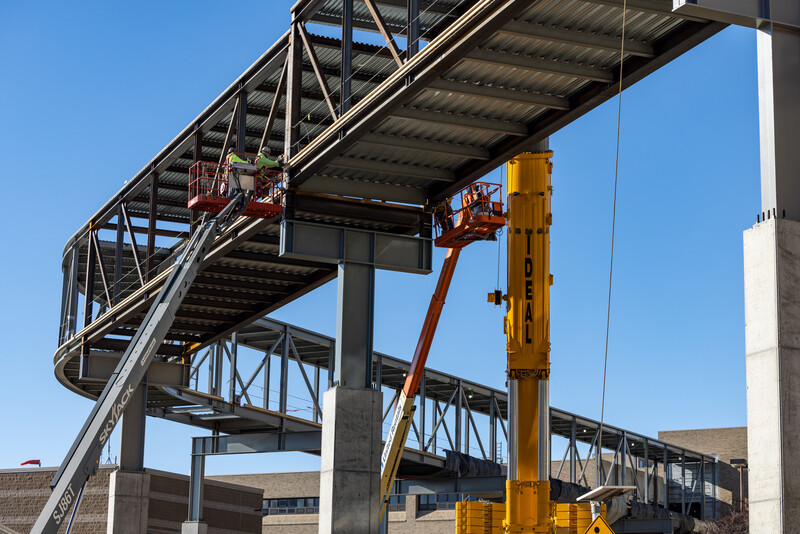Boldt Builds Tunnel in the Sky
Hospitals are increasingly finding ways to segregate patient space from operational space for safety and efficiency reasons, and one Wisconsin hospital took to the air to maintain that separation.
Marshfield Clinic Health System wanted a way to connect its hospital with an east wing building but constructing at ground level would have significantly disrupted daily operations. Instead, construction teams were tasked with building a “tunnel in the sky” to transport patients, linens, food and supplies needed for everyday support.
The Boldt Company worked with HGA Architects to create a 600-foot-long connector bridge that varied in height from 20 feet to 50 feet above the ground. The structure consisted of 10 steel trusses, the longest of which was 70 feet weighing about 45 tons. The entire structure rested on helical piles screwed into the soil at least 30 feet to anchor the connector.
The thought of building the connector onsite was immediately swapped for offsite prefabrication.
To ensure the hospital continued to serve patients during construction, crews left access open to the loading dock and helipad. Patient transport from the helipad to the hospital was done through a tunnel of temporary shipping containers the crews sourced and installed for safe access through the construction site to the facility.
The decision was made to prefabricate the trusses on an empty parking lot near the hospital.
Structural steel was delivered to the staging area and crews built the trusses in a short timeline. For accuracy, crews used their own models to maintain tolerances of +/- ¼ inch so the preassembled sections would fit exactly into the existing structures.
Twelve weeks after construction started, crews were ready to lift the prefabricated truss sections into place. Starting at 5 a.m., crews used a self-propelled modular transport to move the giant sections into place. A 200-ton crane hoisted the sections in the air and crews started work to connect the trusses. The SPMT provided extreme maneuverability on the city street and transport time for each section was about 10 minutes. Once onsite, traffic was only impacted for one day per truss section, rather than having a site-built approach tie up traffic for weeks.
Boldt project managers estimate costs were cut in half by prefabricating trusses versus building right on the jobsite and the overall production timeline was reduced by about 10%. Prefab building at ground level instead of 50 feet in the air also reduced the safety risk by almost 80%.
Daily planning sessions and collaboration required teams to refine production schedules and ensure production costs kept pace with the budget. The production process also managed the staging and timing of offsite prefabrication and onsite installation to compress the overall construction calendar. For healthcare, integrating preconstruction planning and prefabrication are the next generation of construction.
The connector project for Marshfield Hospital will be finished October 2022.
For more information, visit www.boldt.com.
Posted May 20, 2022
More Articles:
- CxA Workshop & Exam
Apr 29, 2024 – Apr 30, 2024 - EMP Seminar & Exam at CxEnergy 2024
Apr 29, 2024 – Apr 30, 2024 - CxEnergy
Apr 29, 2024 – May 2, 2024 - PHCC West 2024
Apr 29, 2024 – May 2, 2024 - Lean in Design Forum 2024
May 1, 2024 – May 2, 2024 - IFMA’s Facility Fusion Conference & Expo
May 5, 2024 – May 7, 2024 - ASHE Academy 2024
May 6, 2024 – May 10, 2024











